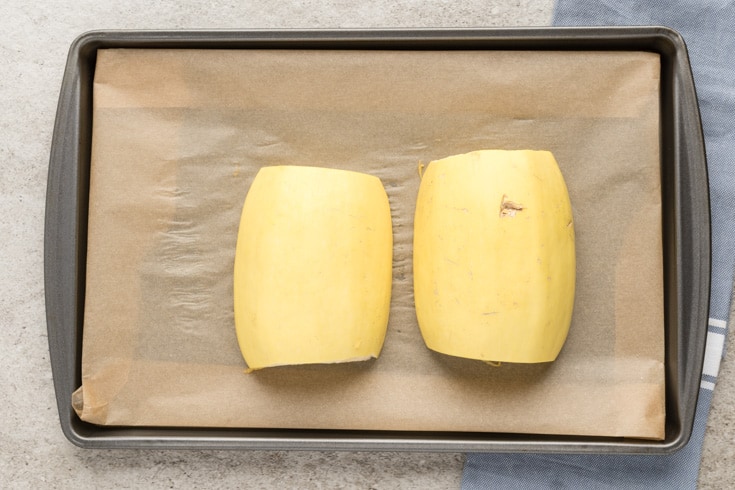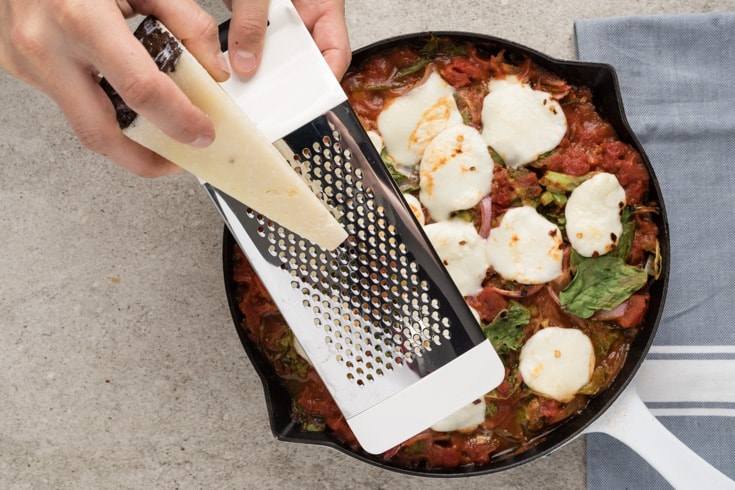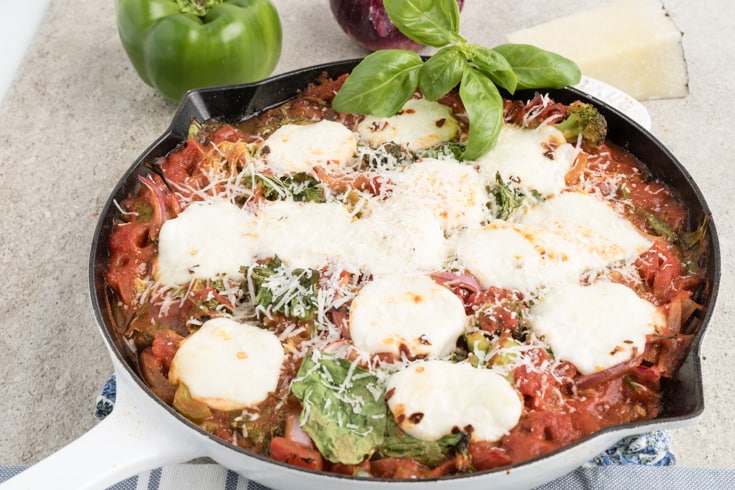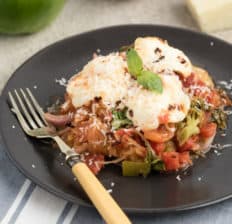Spaghetti Squash Casserole: Loaded with Nutrients

Eating seasonally is one of the best parts about home cooking. And when autumn and winter hits, warm, comforting casseroles fit the bill.
Too often, though, casseroles are recipes packed with heavy, refined carbs and few, if any, vegetables. While they may taste good, you won’t feel too great after a serving. That’s what makes this healthy spaghetti squash casserole such a stellar cold-weather meal.
Here, spaghetti squash replaces the pasta you typically find in casseroles. You’ll add a colorful medley of vegetables, but with both mozzarella and raw goat cheese, this easy-to-make spaghetti squash casserole feels indulgent — it’s the best of both worlds!
Key Ingredients
The key ingredient to this casserole is the spaghetti squash. At first glance, this vegetable doesn’t resemble anything close to spaghetti. But once the squash is cooked, its flesh turns to spaghetti-like strands, perfect for sauces, casseroles or any other meal where pasta is normally used.
Best of all, spaghetti sauces is packed with nutrients you just won’t find in pasta. Its bright hue is thanks to the beta-carotene. This cartenoid is one of the reasons why spaghetti squash is full of antioxidants and great for your skin, eyes and respiratory health.
But spaghetti squash isn’t the only good-for-you ingredient in this healthy casserole. You’ll also include two of the healthiest leafy greens: kale and spinach.

Kale is an impressive anti-inflammatory food. Because it’s full of omega-3s, it helps balance our omega-3 to omega-6 ratio, critical for keeping inflammation at bay. It’s also great for heart health and helping to lower cholesterol and promote cellular health.
Spinach is another green nutrition giant. It helps guard cells from mutations that lead to cancerous tumor growth and protects against heart disease. The fiber found in spinach both slows the blood’s absorption of glucose and reduces cholesterol levels, two important factors in reducing your risk of a heart attack or stroke.
The high levels of vitamins A and C also boost immunity, helping you keep bacteria and viruses at bay. The average casserole recipe cannot do that.

Nutrition Facts
Let’s take a closer look at what one serving (479 g) of this spaghetti squash casserole offers:
- Calories: 325
- Total Carbohydrates: 29.4 g
- Fiber: 6.7 g
- Sugar: 13.2 g
- Total Fat: 16.4 g
- Saturated Fat: 8.9 g
- Polyunsaturated Fat: 1.3 g
- Monounsaturated Fat: 4.4 g
- Trans Fat: 0 g
- Protein: 18.1 g
- Cholesterol: 48 mg
- Sodium: 610 mg (41% DV*)
- Vitamin A: 2723 IU (117% DV)
- Vitamin K: 105 mcg (117% DV)
- Vitamin C: 82.8 mg (110% DV)
- Vitamin B12: 1.2 mcg (48% DV)
- Vitamin B6: 0.589 mg (45% DV)
- Niacin: 6.3 mg (45% DV)
- Phosphorus: 312 mg (45% DV)
- Copper: 0.39 mg (43% DV)
- Calcium: 381 mg (38% DV)
- Manganese: 0.63 mg (35% DV)
*Daily Value: Percentages are based on a diet of 2,000 calories a day.
As you can see, the variety of vegetables in this spaghetti squash casserole make this an easy, vegetarian-friendly main dish. You can also easily make this vegan by omitting the cheese. It’s a well balanced macronutrient meal as well.
How to Make Spaghetti Squash Casserole
So how do you make spaghetti squash casserole? Let’s get started.
Start by preheating the oven to 400 F. While that happens, line a baking sheet with parchment paper and place the halved squash sides on it, face down. Bake the pieces until the squash if fork tender, around 30 to 40 minutes.

While the squash is cooking, chop up your veggies.

When the squash is done, turn the oven heat down to 350 F. We’re not finished with it just yet.
Once the spaghetti squash has cooled off, scrape the flesh into a cast-iron skillet.

Then add in the other ingredients, except for the cheese and basil.

Use a wooden spatula to combine all of the ingredients.
Now it’s cheese time! Top the casserole with the buffalo mozzarella and bake for 25–30 minutes.

When the casserole is out of the oven, grate the goat cheese on top. Finish off with the fresh basil.

This gorgeous, healthy spaghetti squash is officially ready to eat!

Other Healthy Squash Dishes
- Butternut squash ravioli
- Acorn squash soup
- Candied pecan butternut squash salad
- Roasted acorn squash
- Butternut squash soup

Hearty Spaghetti Squash Casserole
- Total Time: 1 hour 25 minutes
- Yield: 4 1x
- Diet: Vegetarian
Description
Of the many varieties of squash, the spaghetti squash is the best one suited for a casserole dish. This one is both fun to make and delicious. It’s also extremely good for you!
Ingredients
- 1 spaghetti squash, cut in ½ length-wise
- 1 cup spinach
- 1 cup kale
- ½ red onion, chopped
- ½ green bell pepper, chopped
- 1 cup broccoli, chopped
- 1½ cup marinara sauce
- ¼ cup fire-roasted diced tomatoes
- ¼ teaspoon sea salt
- ¼ teaspoon pepper
- one 7-ounce package of buffalo mozzarella
- ¼ cup goat cheddar cheese, grated
- fresh basil for topping
Instructions
- Preheat the oven to 400 F.
- On a baking sheet lined with parchment paper, place the squash face down and bake for 30–40 minutes, or until fork tender.
- Reduce oven to 350 F.
- Allow the spaghetti squash to cool and, using a fork, scrape the inside of the squash and place the strands in a bowl.
- In a medium-size cast iron skillet, add the spaghetti squash and remaining ingredients, except for the cheeses and basil.
- Using a wooden spatula, mix everything until well-combined.
- Top with buffalo mozzarella and bake for 25–30 minutes.
- Add the cheese and basil, serve and enjoy!
- Prep Time: 15 min
- Cook Time: 70 min
- Category: Main Dishes
- Method: Oven
- Cuisine: Italian
Nutrition
- Serving Size: 1 serving (479 g)
- Calories: 325
- Sugar: 13.2 g
- Sodium: 610 mg
- Fat: 16.4 g
- Saturated Fat: 8.9 g
- Unsaturated Fat: 5.7 g
- Trans Fat: 0 g
- Carbohydrates: 29.4 g
- Fiber: 6.7 g
- Protein: 18.1 g
- Cholesterol: 48 mg
Comments
Please keep comments under 200 characters.





I have heard that putting acidic foods, like tomatoes, in cast iron is not a good thing–I made this in a glass casserole dish as an alternative.
Can this be frozen?
Absolutely!
What a great recipe, you can do so much with it. Makes great leftovers too.
Thank you dr axe!!!
Topped mine w goat mozzarella.
Gave the veggies a quick sauté w olive oil just because some of them were frozen.
Forgiving recipe, comes together quickly.
Best vegetarian dish ever, and the left overs are even better. I am not. Vegetarian of GF, but I have sensitivities to the bad stuff. 3 years ago my son was diagnosed with autism and I suspect that I am autistic too, since then a lot of changes in my life. Thank you for share your knowledge and this wonderful receipt.
Dear Gay Abarbanell,
On my phone, where the social media icons are, there is a printer icon.
Please add a ‘print’ option for these great recipes
Can you freeze this?
Thank you for sharing this recipe. It was SO good! I will try this one! but i saw this website Fanf World update 3
Thank you for sharing this recipe. It was SO good! Will definitely make again.
Thanks it looks yummy I love cooking
So you used nightshades, FULL OF LECTINS, and unless they are pressure-cooked, cause leaky gut.
“4. Nightshades – Nightshades are vegetables that include eggplant, any kind of pepper, potatoes, and tomatoes. The peels and the seeds of these plants contain loads of lectins, too. Make sure to peel and deseed them or pressure cook or ferment them. All these techniques reduce the amount of lectins.” Gundry
Sounds and looks Excellent! I will try this one!!
Thank you
Looking good
I am going
Make it to night
I am sure
It will
Be good
Also
When I take juice out
I will not throw it away I will put it in my salad dressing and eat it has lot nutrition vitamin in the juice thank you????????
Dear Betty
Put
The juice from
Veggies
In your salad dressing only add more vinegar
your favor
organic apple cider or balsamic
Enjoy It
Hi,
I just prepared this dish tonight. I forgot to buy the kale, so I added an extra cup of spinach. I also used 1/2 sweet yellow onion as I am sensitive to other onions. Also topped it with some black olives and the basil I used was fresh picked from my garden. I love the Fall season and eating the squash and other veggies that are fresh and ripe now!
This was absolutely delish! Thank you, Dr. Axe, for sharing this amazing recipe- I give it 5 stars!
Blessings :)
We tried this tonight and it was s bit watery. Is that normal?
Hello Betty, it is normal for the Spaghetti squash to be a little watery. To eliminate excess, you may want to strain the veggies before moving onto step 5 and 6.
I have made bone broth for the 1st time. How much do I put in a cup.
I have only recently tried kale. t made my tongue itch. Is this a sign of food allergy?
Hello Danell, You may want to reach out to your physician to see if kale is a food sensitivity for you.
A delicious recipe, we enjoyed it last night for dinner. 5 stars
So glad that you liked the recipe. Enjoy!